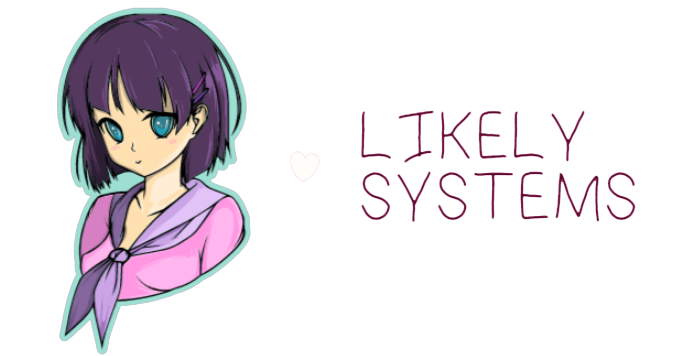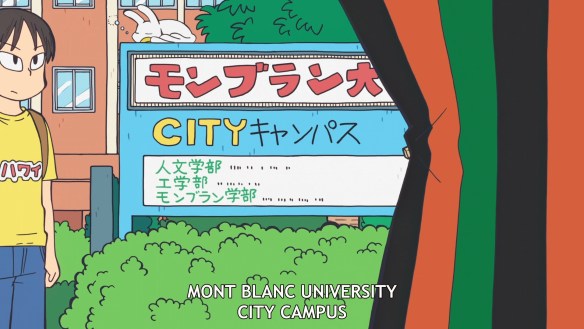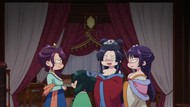Hello folks, and welcome back to Wrong Every Time. Today I’m delighted to announce we’re taking a walk downtown, as we return to the manic, seemingly free-associated antics of CITY the Animation. As with its Arawi-penned predecessor Nichijou, CITY has established a diverse collection of local characters with their own concerns and social groups, from our Nagumo-centered main trio to the irreverent high schooler pair to the perpetually harried newspaper editorial department. Through their preposterous shenanigans, Arawi’s pen and Ishidate’s team are summoning the lively, lovable energy of a city in motion, a community that is greater for every unexpected link between its various component parts.
CITY has so far actually felt a bit more invested in this “communal texture” effect than Nichijou’s more farcical, localized approach; Ishidate has stated in interviews that he’s more focused on creating a certain warm, inviting atmosphere than emphasizing laugh-out-loud gags, and I’d say the production is better for it. Nichijou’s moments of familial bonding were often its greatest; though the show was full of incredible comic vignettes, it’s the love shared by Yuko, Nano, and all their friends that holds most clearly in my mind. With the last episode offering the sharp, unexpected stinger of Eri potentially moving away from her best friend Matsuri, I imagine we’ve got plenty of similarly tender moments ahead of us, and I’m eager to get back to the family. Let’s enjoy the CITY!
Episode 3
We open with the wood block fanfare and tri-colored curtains that I’ve come to understand traditionally precede kabuki performances, purely by how often those signifiers are used for kabuki-related gags in anime. It sure is a strange, fragmentary understanding of Japanese culture that anime provides us
Nagumo pops up in the bushes and then flees from her landlord, an incident entirely unrelated to the current university-set skit. One of the many tricks this production employs to maintain a sense of continuity and community across its cast, populating all of its segues with little gestures towards other ongoing stories
Oh my god, this zoom into the theater clubroom is preposterous. City takes “movement into depth” cuts to an outrageous new standard, capitalizing on its simplified color design and intelligent use of CG backgrounds to move the camera through entire hallways or city blocks, accepting the continuous redraws of active characters any such movement will require. The production is a testament to the flexibility of animation-friendly designs – with practically no shading or complex linework, it is far easier to continuously animate a pan around or past a given character
This goofy wipe cut also embraces the show’s simplified geometric style, presenting the entire scene as a cube that can be spun towards a different face
Fun uses of sound design as our playwright reveals his masterpiece, further leaning into the percussive elements of kabuki theater
And of course, the punchline is an extreme anticlimax: his theater troupe are all stuffed animals
God, this OP is such a powerful mood. The beautiful everyday struggle of coexisting
Wait, no, they’re actual animals, as demonstrated through their rejection of his convoluted apologies
City feels perhaps even more dedicated than Nichijou to following a rambling train of thought wherever it goes, with less focus on specific punchlines than on embracing the surrealism of these characters’ fundamentally absurd relationships. It constructs bizarre little paradigms and then treats them with absolute confidence, like the implications inherent in our playwright stating that “Fighting Monkey’s punches are even stronger than before”
Also like that Fighting Monkey doesn’t really have a head, just a torso with a face in its upper region
We then jump to Riko Izumi, a seemingly perpetually sleepy girl who appears to go to the same school as Eri and Matsuri
Ooh, love this melting colors effect as we transition to her life flashing before her eyes. Another neat effect facilitated by this production’s clean block colors
Izumi barely touches the ground as she floats out of school. Between her character acting and the replacement of any sound design with a light piano melody, the production is doing an excellent job of echoing her half-asleep headspace
Nice mix of universal nostalgic touchstones and flourishes of absurdism in these memories
Fantastic punchline of this bench-painter rushing not to stop her from sitting on wet paint, but to replace the wet paint sign with a “dry paint” one. Classic gag of reversed expectations made all the better by the inherent absurdity of needing to put up a “dry paint” sign in the first place, as well as his proud confidence in having actually accomplished something by doing so
And then, of course, they challenge even the base concept of these repeated life-flashing-before-your-eyes montages, by assigning the next one to the takoyaki she just dropped. Just when the joke seems to be wearing out its welcome, they double down with a fresh curveball that invigorates the concept. Arawi is an old hand at the truism that jokes start funny, become stupid upon repetition, and then become funny again upon even more repetition
The title card transition featuring the two octopi in love really emphasizes where Arawi’s heart is at – these stories are absurd, but he genuinely commits to the love shared by their characters. Just because something is self-aware or tongue-in-cheek doesn’t mean it can’t also be deeply felt
Our jump to a bakery offers continuity between these stories in a different way, with a poster celebrating the theater club production hanging on the wall
“Your choices in bread are your choices in life.” This whole sequence is basically a gag of misplaced genre signifiers, presenting the process of getting bread from a bakery as some kind of metaphor-rich, high-stakes locked room mystery
Meanwhile, the high school pair are fine-tuning their plan for world peace
Their first consideration, of course, is to ensure that nobody steals their idea and their well-earned Nobel Peace Prize
“Let’s maintain the peace inside the well.” Their free-associated ramblings are largely meaningless, but they arrive at a genuinely solid point – as individuals, our ability to promote peace in the world is largely limited to promoting peace in our own immediate surroundings. Arawi’s collective works are a testament to the importance of doing our share to promote kindness among the people close to us, which can collectively create a community worth celebrating
“You get a Matsuri Peace Prize.” Ecchan nearly tears up at this gift. World peace is indeed possible, if you come to understand and appreciate the contours of your own personal world
Love Nagumo’s casual slouch as we jump to Niikura’s apartment. You rarely see characters actually inhabit their clothes in distinct ways in anime – it’s more of a thing in manga, where individual images can convey more of a relationship between character and costume. Killua from Hunter x Hunter feels like a strong anime example; you can tell he knows fashion and enjoys dressing well, but also would never draw attention to those facts
Izumi’s dinosaur pajamas are also very good, and neatly reflect her fanciful, childlike personality
Niikura is definitely the straight man of this group, as demonstrated by her literally crafting a harisen so she can perform her role as tsukkomi, but the key to Nichijou and City alike is that all of these characters can be drawn into lunacy, everyone enjoys the preposterous opportunities of their daily lives
Meanwhile, Nagumo takes Yuuko’s role, but is clearly quite a different personality – she’s more grounded in reality, and also a competitive tomboy. You can see why Niikura admires her; she takes what she wants boldly, without hesitation
Actually laughed out loud at Wako proudly revealing her “water spider technique” of wooden floaty shoes, and then walking into the river and sinking instantly. Just the total lack of reaction or hesitation absolutely killed me, alongside the final image of her hat floating merrily downstream
That gag of anticlimax is immediately contrasted against a sequence of utter maximalism, as the other two make an absurd array of strange noises while digging up a demon skull
The subsequent establishing shot of this shrine shows off this production’s signature mixture of flat colors and depth-rich compositions. It’s hard to make a shot like this not feel busy or lacking in depth, but the arrangement of lines drawing the eye deeper into the composition (the pathway, the array of posts) ensure this feels like a voluminous space
This ED is just as inviting as the OP. I want to live in this world!
We return to Izumi at school for the epilogue, where we are immediately greeted by a preposterous overhead shot revealing an entire classroom’s worth of uniquely designed characters. From K-On! onwards, Kyoto Animation have always gone the extra mile in filling their schools with unique recurring students
They immediately put those designs to work, debuting Adatara the paper airplane master as if he’s an old friend
Excellent variation on the gag as Adatara’s third announcer steals the fourth’s “the modern day William Tell!”
And Done
Oh my god, this show is such an overwhelming delight. Though the focus is still clearly on fostering a warm, inviting atmosphere over individual punchlines, the punchlines were nonetheless excellent this episode, with Izumi’s sequences in particular demonstrating Arawi’s keen understanding of how to exploit comic convention and audience expectations in order to provoke totally unexpected comedic payoffs. That dry paint sign is just such a perfectly stupid concept, and I’m already loving the students of her class and their hero, the ever-reliable Adatara. It also feels like the Nagumo-Niikura-Wako trio are solidifying their dynamic, offering a somewhat more grounded take on Nichijou’s main trio that embraces City’s general preoccupation with the daily victories and failures of young adult life. I’m so happy this delightful little world exists.
This article was made possible by reader support. Thank you all for all that you do.




